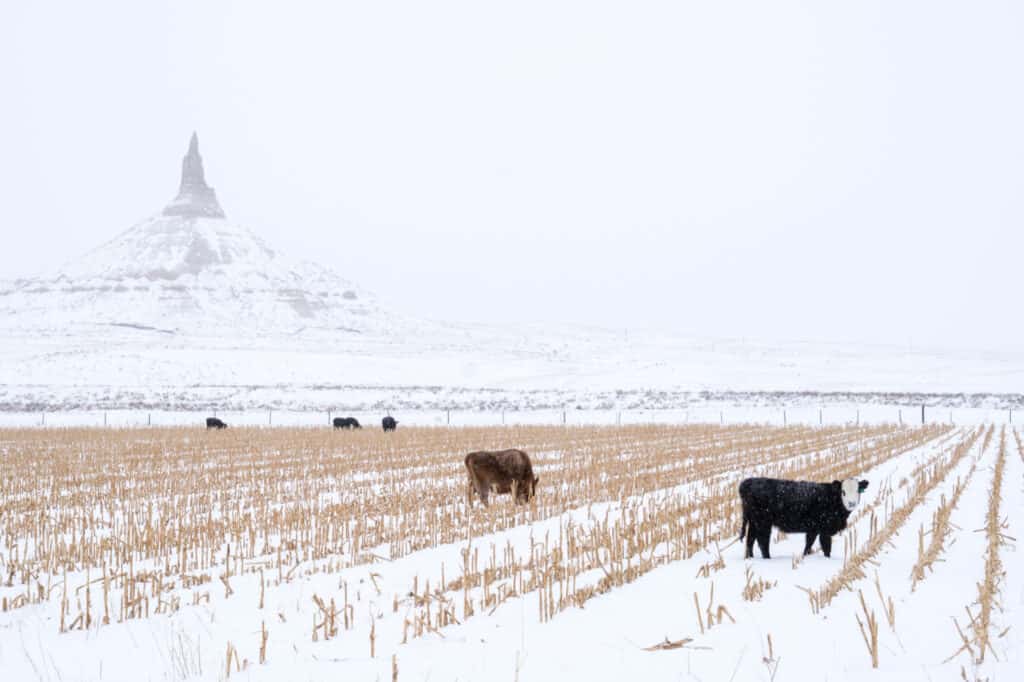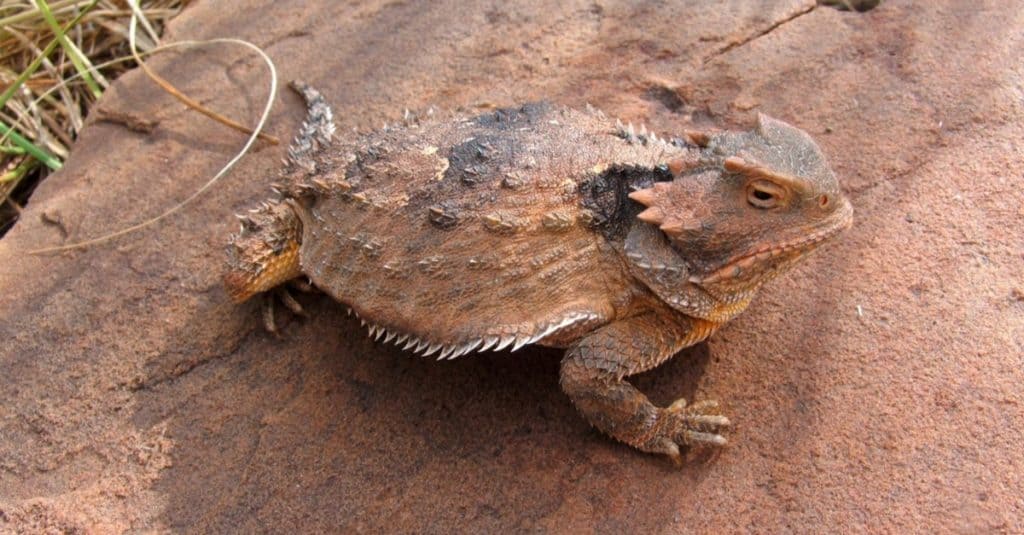Anyone who has spent any time in the Midwest knows that winters can be a bit… challenging. Between epic snowstorms, bitter cold, and wide open spaces that invite blizzard conditions, residents of states like Nebraska get used to relatively harsh periods every winter.
But what is the snowiest place in Nebraska? The answer is in the article below! Additionally, we explore what sort of recreation opportunities exist in such a snowy environment and what kinds of animals live in the area.
What Is the Snowiest Place in Nebraska?
Even with as much snow as Nebraska averages each year, one location stands out above the rest. And that is Bushnell, Nebraska. Residents there have to combat approximately 48.16 inches of snow every year.
But Bushnell just barely outpaces the second snowiest place in Nebraska. Harrison receives an average of 47.61 inches annually. So they are close to taking over the top spot.

Winters in Nebraska can be very harsh and snow-filled.
©melissamn/Shutterstock.com
Where Is Bushnell, Nebraska?
Bushnell is not quite big enough to even be a town. It is officially categorized as a village, and it is in Kimball County, Nebraska, in the southwest corner of the state. Kimball County is not very big, either. It consists of one city (Kimball), a second village in addition to Bushnell, and four unincorporated communities.
The quaint village was founded in 1867 and named after Cornelius Scranton Bushnell. And at the time of the 2010 census, 124 people lived in Bushnell.
What Is the Snowiest Place in the United States?
However, despite how snowy it feels to have nearly 50 inches fall every year, that is nothing compared to the snowiest place in the United States. Based on averages compiled over the most recent 30 years, Crater Lake National Park, Oregon, holds the crown for the snowiest location in the US. The park receives 463.1 inches on average annually.
Things to Do in Bushnell, Nebraska, in the Winter
Bushnell itself doesn’t have designated recreation areas. However, Kimball County does. The county is home to Oliver Reservoir State Recreation Area.
Oliver Reservoir State Recreation Area is 917 acres and includes a 264-acre lake. Due to the cold winter weather, the recreation area does not allow camping during the winter. The recreation area is for day use only. But that does not stop fishermen from heading out to enjoy their sport even in the coldest months!
Additionally, great hiking and biking trails are open and ready to use in between snowstorms. And if enough snow piles up, you can even strap on your snowshoes for a lovely outing.

Kimball County, Nebraska, has wide-open vistas.
©Ammodramus / CC0 1.0 – License
What Animals Live Around Bushnell, Nebraska?
The plains are actually teeming with life. So residents and visitors to Bushnell get a treat whenever they spend time outside enjoying nature. Here is a small taste of what lives there.
Mammals
Surprisingly, the plains are not quite as empty as one may think! The area around Bushnell is home to over 60 mammals. When you spend time outside, you may come across black-footed ferrets, mice, shrews, three different myotis species, six bat species, pronghorns, American badgers, wapitis, two types of foxes, white-tailed deer, bobcats, American minks, or mountain lions.
Fish
Many anglers (from beginners to professionals) love hitting up the waterways in Nebraska. There is world-class fishing almost everywhere you go. And Kimball County is no different. Keep an eye out for European carp, bluegill carp, channel catfish, crappie, tiger muskie, walleye, and yellow perch.
Birds
With over 240 species of birds soaring in the skies around Bushnell, the birding is nearly unmatched. So bust out your binoculars to look for white-rumped sandpipers, ferruginous hawks, pine grosbeaks, multiple owl species, long-billed curlews, rusty blackbirds, red-breasted mergansers, mountain chickadees, ospreys, mountain bluebirds, and golden eagles.
Amphibians
There are also plenty of amphibian species in the area, including two toad species, two leopard frog species, bullfrogs, plains spadefoots, Blanchard’s cricket frogs, barred tiger salamanders, and boreal chorus frogs.
Reptiles
When you are out enjoying the sunshine in Nebraska, make sure to pay attention underfoot. Lots of reptiles are creeping along under bushes or sunning themselves on rocks. You may see greater short-horned lizards, plains garter snakes, gopher snakes, common snapping turtles, prairie rattlesnakes, and many-lined skinks.
Others
Additionally, there are numerous species of insects, arachnids (be careful to ticks), beetles, grasshoppers, moths, bugs, bees, and butterflies.

Greater short-horned lizards are among the many reptile species living in Kimball County, Nebraska.
©Matt Jeppson/Shutterstock.com
The photo featured at the top of this post is © melissamn/Shutterstock.com
FAQs (Frequently Asked Questions)
What is the most snow recorded in Nebraska?
The record for the highest single-day snowfall in Nebraska goes to Omaha, which received 18.3 inches on February 11, 1965.
Is Nebraska or Chicago colder?
Omaha, Nebraska, is slightly colder than Chicago. However, the windy city gets significantly more snowfall. The average annual snowfall in Chicago is 37.8 inches compared to Omaha’s 26.5 inches.
What is the coldest city in Nebraska?
Valentine, Nebraska, is known for having the lowest average temperatures in the entire state. The annual average temperature is only 48 degrees.
Thank you for reading! Have some feedback for us? Contact the AZ Animals editorial team.






